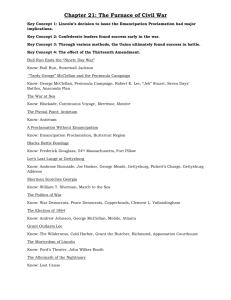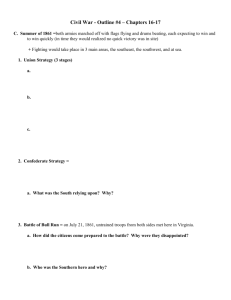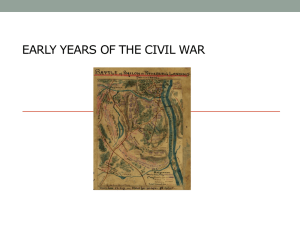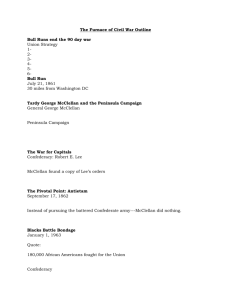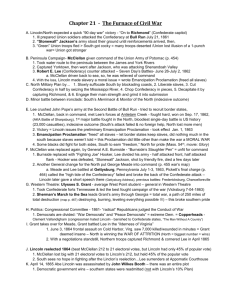Lsn 1 Intro
advertisement
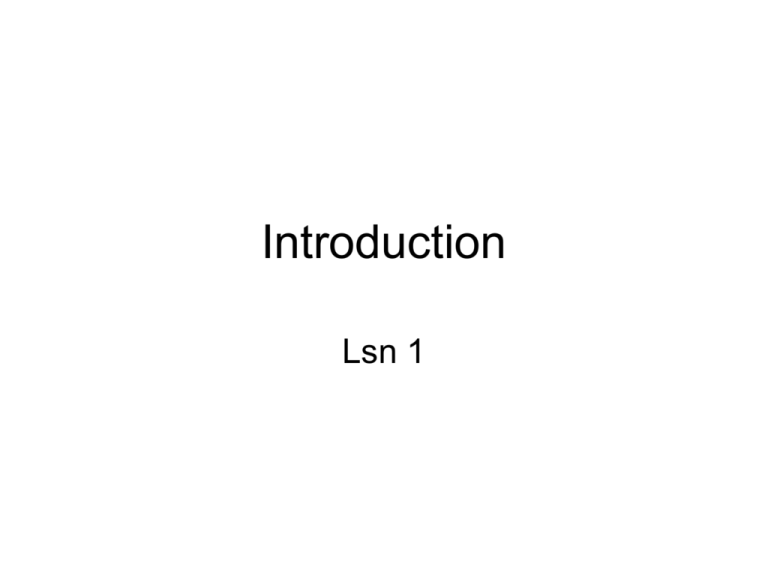
Introduction Lsn 1 HIS 351: US Military History 1860 to the Present • Kevin Dougherty – kevin.dougherty@usm.edu – 266-4455 – Room 449 – http://ocean.otr.usm.edu/~w416373/ HIS 351: US Military History 1860 to the Present • Focuses on the operational aspects of the American military experience • Uses professionally accepted analytical tools to understand the wars, campaigns, and battles – – – – – Principles of war Facets of the operational art Characteristics of the offense and defense Tenets of leadership etc Jomini’s Three Kinds of Military History • The Pure Version – The recounting in minute and pedantic terms all aspects of a given battle – Done in an antiquarian way without much concern for useful analysis • The Analytical Version – Used the account of a campaign or battle to examine the principles that apply to the waging of war – Involved analysis of the relationship between events and principles – Studied in the broad context could reveal something of the evolution of the art of war • Political Military History – The examination of war in its broadest spectrum through association of the military with the political, social, and economic factors HIS 351: US Military History 1860 to the Present • Discusses the military as an American institution and places it in its role in American society – The Constitution – National Security Strategy – Civilian control – Social implications HIS 351: US Military History 1860 to the Present • Text – Robert Doughty, et al, American Military History and the Evolution of Western Warfare, Lexington, MA: D. C. Heath and Company, 1996 and assigned articles • Grading – Midterm Exam 200 points – Unannounced Quizzes (10 at 10 pts each) 100 points – Book review 100 points – Student Presentation 100 points – Writing Assignment 300 points – Final Exam 200 points HIS 351: US Military History 1860 to the Present • Midterm Exam – Short Answer (5 to 10 sentences) and “ID & SIGs” (in 2 to 4 sentences identify and state the significance of a term) • Unannounced Quizzes – Fill in the blank using ID & SIGs from that day’s lesson • Student Presentation – Pick a topic listed under selected lessons and prepare a 7 to 10 minute powerpoint presentation to be given that lesson. Grade based on content and effective communications • Final Exam – Comprehensive – ID & SIGs, Short Answer, and Essay Writing Requirement • 1,800 to 2,200 word battle or campaign analysis – You pick the battle or campaign. Can be one we discussed in class or another, but I must approve it. – Use one of the analytical tools we discuss in Block 1 to analyze the battle or campaign • On Lsn 14, bring in your introductory paragraph • Writing assignments are due Lsn 21 Analytical Writing • GRE Analytical Writing Measure assesses the applicant's ability to articulate complex ideas clearly and effectively examine claims and accompanying evidence support ideas with relevant reasons and examples sustain a well-focused, coherent discussion control the elements of standard written English Thesis • “a position or proposition that a person ... advances and offers to maintain by argument” • Webster’s Dictionary Writing Style • Put the thesis and proofs -- the “bottom line” -- in the first paragraph (BLUF = Bottom line up front). • Each paragraph addresses one main idea and that idea is clearly stated in the topic sentence. – Write paragraphs that average 5 to 7 sentences in length. • Document using MLA or Turabian. – Use college-level sources. If your main source is wikipedia or some other .org source, you’re probably not using appropriate sources. • Do not use contractions. Writing Style • Use quotations for impact (to cite an authority, to get exact wording, or to connect an important person with a particular thought). Put them in context. Do not have a whole sentence be a quotation. • Avoid the first person. • If you feel compelled to use them at all, use rhetorical questions sparingly. • Use the active voice. • Write for your audience, but, in general, keep it simple – Use short sentences (an average of 15 or fewer words). – Understand the words you use. • Use correct spelling, grammar, and punctuation. Organization: “M1A1 Paper” • Intro… tell them what you’re going to tell them • Body… tell them • Conclusion… tell them what you told them Example • Introduction – Robert E. Lee defeated George McClellan in the Peninsula Campaign because of the superior Confederate intelligence system. This advantage manifested itself in terms of synthesis, analysis, and collection. In terms of synthesis, Lee was able to assemble John Magruder’s initial panicky reports and develop a reconcentration of forces in response. In terms of analysis, McClellan’s exaggerated estimates of Confederate troop strength led him to be cautious when he should have pressed his advantage. In terms of collection, Jeb Stuart’s cavalry gave Lee had an intelligence gathering asset that McClellan could not match. Lee’s superior intelligence system allowed him to act faster and more accurately than McClellan could and gave Lee a decisive advantage on the Peninsula. Example • Para 2 – Analysis (McClellan’s exaggerations) • Para 3 – Synthesis (Magruder’s reports) • Para 4 – Collection (Stuart) Example • Conclusion – The key factor in the Confederate victory in the Peninsula Campaign was superior intelligence. McClellan was cautious by nature and his inaccurate magnifications of the Confederate troop strength made him more so. Especially at this point in the war, Confederate cavalry was far superior to its Federal counterpart, and Stuart’s ride around McClellan’s army informed Lee of a vulnerability he could exploit. Finally, Lee had the personal ability to assemble complex and disorganized data into a solution and he used this skill to make sense of Magruder’s initial panicky reports. In all respects, intelligence gave the Confederates an advantage and Lee turned this advantage into victory on the Peninsula. Book Review • Choose a book from the list in the syllabus and write a 600-800 word review that – Identifies the book and the author • Include a brief biographical sketch of the intellectuallysignificant aspects of the author’s life (What is his experience and expertise in the area of the book’s subject?) • Discuss the relationship between the book being reviewed and other works in the field – Summarizes the book • Include short quotations from the book that are representative of the theme, tone, and style – Evaluates the book • Evaluation must be clearly presented and well-supported • Due Lsn 23 HIS 351: US Military History 1860 to the Present • Four Blocks – Military Theory and Doctrine – The Civil War – The Interwar Period, World War I, and World War II – Early Cold War, Korea, and Vietnam HIS 351: US Military History 1860 to the Present • • • • • Office Hours Academic Honesty Classroom Conduct Absences ADA How to Succeed • • • • • • • • Plan ahead/Prioritize Come to class Do the reading Print out the slides (using “handouts” option; 6 per page) Highlight the ID & SIGs on the slides Take your class notes directly on the slides Use the exam study guides to prepare for exams Use me and the History Writing Lab for help with your papers • Use the “backward planning process” to help focus your paper preparation Backward Planning Process • • • • • • • Due Finalize Writing lab draft Works Cited Paras 4 and 5 Paras 2 and 3 Prep Day/Obtain all sources/Make outline • Workshop/Finalize introduction • Write draft introduction • Determine proofs • Write thesis • Initial research • Pick a subject • Today Next • Military Theory Clausewitz
